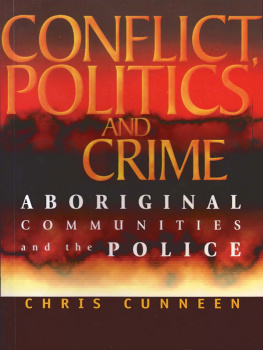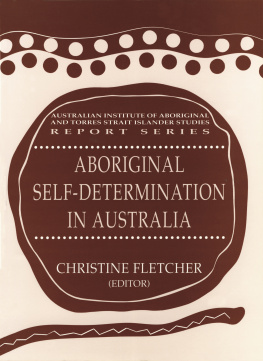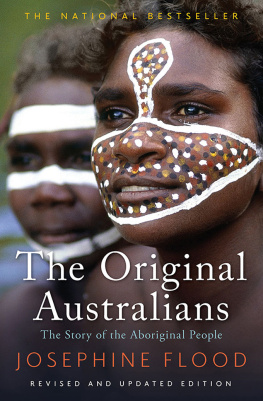CONFLICT, POLITICS AND
CRIME
Chris Cunneen is Associate Professor in Criminology and Director of the Institute of Criminology, Sydney University Law School. He has published widely on Aboriginal people and the criminal justice system, an is the co-author of Indigenous People and the Lawin Australia (1995) and Juvenile Justice: An Australian Perspective (1995). He co-edited Faces of Hate: Essays on the Incidence and Natureof Hate Crime in Australia (1997).
CONFLICT, POLITICS
AND CRIME
Aboriginal Communities and the Police
Chris Cunneen
ALLEN & UNWIN
First published in 2001
Copyright Chris Cunneen 2001
All rights reserved. No part of this book may be reproduced or transmitted in any form or by any means, electronic or mechanical, including photocopying, recording or by any information storage and retrieval system, without prior permission in writing from the publisher. The Australian Copyright Act 1968 (the Act) allows a maximum of one chapter or 10% of this book, whichever is the greater, to be photocopied by any educational institution for its educational purposes provided that the educational institution (or body that administers it) has given a remuneration notice to Copyright Agency Limited (CAL) under the Act.
Allen & Unwin
83 Alexander Street
Crows Nest NSW 2065
Australia
Phone: (61 2) 8425 0100
Fax: (61 2) 9906 2218
Email: frontdesk@allen-unwin.com.au
Web: http://www.allenandunwin.com
National Library of Australia
Cataloguing-in-Publication entry:
Set in 10/12 pt New Baskerville by DOCUPRO, Canberra
Printed by CMO Image Printing Enterprise, Singapore
10 9 8 7 6 5 4 3 2 1
Contents
This book has grown out of many years of work with colleagues and friends. It has benefited immensely from their discussions, critiques and insights. I would like to particularly thank Paul Behrendt, Greta Bird, Harry Blagg, Nerida Blair, Jim Brooks, Murray Chapman, Mick Dodson, Mark Findlay, Cec Fisher, Terry Libesman, Garth Luke, David McDonald, Francis and Greg McKellar, Gary Martin, Irene Moss, Kate Munro, Clearie Quayle, Julie Stubbs, Roberta Sykes, Rob White and Sue Zelinka. Many Indigenous organisations have assisted my research work including Aboriginal Legal Services, Aboriginal Justice Advisory Committees, ATSIC, and the Aboriginal and Torres Strait Islander Social Justice Unit in the Human Rights and Equal Opportunity Commission. I would also like to thank Natalie Brown, Zena Dabboussy and Mary Spiers who have worked with me as research staff on various projects which are reflected in this book. Amanda Andreazza assisted with the preparation of the manuscript. Finally, thanks to John Iremonger, Karen Penning, and Emma Cotter from Allen & Unwin, as well as their anonymous reviewer.
| AAPA | Australian Aboriginal Progressive Association |
| ABS | Australian Bureau of Statistics |
| ACLOs | Aboriginal Community Liaison Officers |
| ADB | Anti-Discrimination Board (New South Wales) |
| ALRC | Australian Law Reform Commission |
| ATSIC | Aboriginal and Torres Strait Islander Commission |
| CAT | Convention Against Torture and Other Cruel or Degrading Human Treatment |
| CDEP | Community Development Employment Program |
| CEDAW | Convention for the Elimination of Discrimination Against Women |
| CERD | Convention on the Elimination of All Forms of Racial Discrimination |
| CROC | Convention on the Rights of the Child |
| EAC | Ethnic Affairs Commission |
| HREOC | Human Rights and Equal Opportunity Commission |
| ICCPR | International Covenant on Civil and Political Rights |
| ICESCR | International Convention on Economic, Social and Cultural Rights |
| ICJ | International Commission of Jurists |
| NAALAS | North Australian Aboriginal Legal Aid Service |
| NATSIS | National Aboriginal and Torres Strait Islander Survey |
| NISATSIC | National Inquiry into the Separation of Aboriginal and Torres Strait Islander Children from Their Families |
| OCR | Operations and Crime Reviews |
| PTSD | Post Traumatic Stress Disorder |
| SWOS | Special Weapons and Operations Squad |
| TRG | Tactical Response Group |
| WGIP | [United Nations] Working Group on Indigenous Peoples |
1
Introduction
This book is an analysis of policing in Indigenous communities. (I have used the terms Aboriginal, Indigenous and Aboriginal and Torres Strait Islander interchangeably throughout the text.) The book is not concerned with the institution of policing per se, nor does it rest on an essentialist view of the inherent nature of Indigenous societies or cultures as monolithic or static. Rather it seeks to explore what is particular about the relationship between the institution of policing and Indigenous communities in Australia within a historical and contemporary framework.
Poor relations between police forces and Indigenous communities throughout Australia have been a regular source of local, national and international criticism of the failure of governments to improve standards of policing and eradicate racist behaviour in public institutions. One of the most extensive royal commissions in the history of Australiathe Royal Commission into Aboriginal Deaths in Custodywas established after numerous deaths in police and prison custody. After an exhaustive inquiry into 99 deaths (63 of which were in police custody) Commissioner Elliot Johnston concluded the following:
Let me say at once, it is my opinion that far too much police intervention in the lives of Aboriginal people throughout Australia has been arbitrary, discriminatory, racist and violent. There is absolutely no doubt in my mind that the antipathy which so many Aboriginal people have towards the police is based not just on historical conduct but upon the contemporary experience of contact with many police officers (Johnston 1991a, vol. 2, p. 195).
It is perhaps a similar point that Aboriginal writer and ex-prisoner, Kevin Gilbert, had made a decade and a half before the Royal Commission: The real horror of Aboriginal Australia today is locked away in police files and child welfare reports. It is a story of private misery and degradation, caused by a complex chain of historical circumstance, that continues into the present (Gilbert 1978, pp. 23).
Numerous government inquiries over recent years have investigated the factors impacting on relations between Indigenous people and the police. Indeed, the issue has been widely canvassed since the early 1980s. Many of these reports involved substantial recommendationsthe most extensive of which was the Royal Commission into Aboriginal Deaths in Custody and its 339 recommendations, many of which were directly related to policing matters. There is also a substantial and growing body of academic literature which refers to various aspects of Indigenouspolice relations. While there are gaps in the research which need to be remedied, overall it is clear that considerable resources have gone into identifying various aspects of the relationship between Aboriginal and Torres Strait Islander people and criminal justice agencies. Yet, despite the plethora of inquiries, reports and their respective recommendations, the level of over-representation of Indigenous people in the criminal justice system has not significantly improved, and the issue of poor relations between police and Indigenous people remains as significant as ever.
Next page





